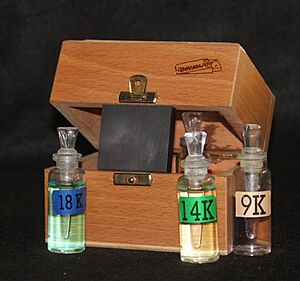Touchstone (assaying tool) facts for kids
A touchstone is a special, dark, flat stone. It's often made from rocks like slate or lydite. People use it to test how pure valuable metals are, like gold or silver. The stone has a very smooth surface. When you rub a soft metal on it, the metal leaves a clear mark.
Contents
How People Used Touchstones Long Ago
Ancient Discoveries
People have used touchstones for a very long time! They were first used around 2600 to 1900 BC. This was during the Indus Valley civilization, a very old civilization in what is now India and Pakistan. People in Ancient Greece also used them.
Gold and Money
The touchstone made it easy to quickly check how pure a metal was. This was super helpful, especially for gold. Because of the touchstone, gold became a popular way to trade and pay for things. Even if coins were mixed with cheaper metals, a touchstone could show how much real gold was inside. This helped people know the true value of their money.
How a Touchstone Works
Testing Gold Purity
Imagine you have a piece of gold and you want to know how pure it is. You would rub it on the touchstone. This leaves a thin line of gold on the stone.
Different types of gold, like 14-karat or 24-karat, have slightly different colors. You can compare the line from your unknown gold to lines made by gold samples of known purity. This simple comparison has been used for thousands of years.
Using Special Liquids
Today, people can do even more tests. After making a line on the stone, they can add a tiny drop of special liquid. One common liquid is nitric acid. Another is called aqua regia, which is a mix of strong acids.
These liquids react differently with gold depending on its purity. For example, 24-karat gold (which is very pure) won't react much. But 14-karat gold will show a chemical reaction. This helps experts figure out exactly how pure the gold is.
See also
- Litmus test
- Spot analysis
- Streak test


